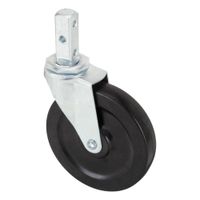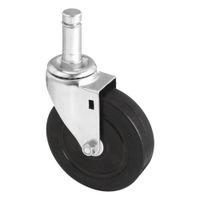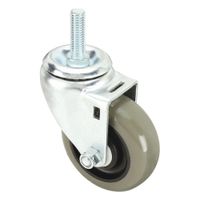Call +(254) 703 030 000 / 751 483 999 / 721 704 777
- Home
- Material Handling
- Casters Wheels
- Stem Casters
.....Read More

Bolt-In Stem Casters with Round & Square Stems

Corrosion, Debris- & Heat-Resistant Standard Threaded Stem Casters

Expanding Stem Casters

Friction-Ring Stem Casters

Grip-Neck Stem Casters

Medical Equipment Standard Threaded Stem Casters

NSF-Listed Sanitary Standard Threaded Stem Casters

Standard Threaded Stem Casters
Frequently Asked Questions
What are stem casters used for?
Stem casters are used to provide mobility and support to various types of furniture and equipment. They are commonly found in environments where items need to be frequently moved or repositioned, such as in offices, hospitals, workshops, and homes. Stem casters consist of a wheel attached to a stem, which is inserted into a socket or bracket on the item being mobilized.
Key uses of stem casters include:
1. **Furniture Mobility**: They are often used on chairs, tables, and desks to allow easy movement across floors. This is particularly useful in office settings where furniture needs to be rearranged frequently.
2. **Medical Equipment**: In hospitals and clinics, stem casters are used on medical carts, beds, and equipment stands to facilitate quick and smooth transportation of medical supplies and devices.
3. **Industrial Applications**: In warehouses and factories, stem casters are used on carts, racks, and machinery to enhance operational efficiency by enabling easy relocation of heavy items.
4. **Retail and Display**: Retail environments use stem casters on display units and shelving to allow for flexible store layouts and easy cleaning access.
5. **Home Use**: In residential settings, stem casters are used on items like kitchen islands, storage units, and plant stands to provide versatility and ease of cleaning.
6. **Specialized Equipment**: They are also used in specialized equipment like camera tripods, musical instrument stands, and stage equipment to provide stability and mobility.
Stem casters come in various materials, such as rubber, plastic, or metal, to suit different floor types and load requirements. They may also feature locking mechanisms to secure the item in place when needed.
How do you install threaded stem casters?
To install threaded stem casters, follow these steps:
1. **Select the Right Casters**: Ensure the casters are suitable for your furniture or equipment, considering weight capacity, wheel material, and stem size.
2. **Prepare the Furniture**: Turn the furniture or equipment upside down to access the legs or base. Ensure the surface is stable and secure.
3. **Drill Holes (if necessary)**: If the furniture does not have pre-drilled holes, use a drill to create holes in the center of each leg. The hole diameter should match the diameter of the caster stem.
4. **Insert Threaded Inserts (if needed)**: For wooden legs, you may need to install threaded inserts to provide a secure fit. Use a hammer or mallet to gently tap the insert into the drilled hole, ensuring it is flush with the surface.
5. **Screw in the Casters**: Align the threaded stem of the caster with the hole or insert. Turn the caster clockwise to screw it in. Use a wrench or pliers to tighten the caster securely, ensuring it is straight and stable.
6. **Check Alignment and Stability**: Once all casters are installed, check that they are aligned and the furniture is level. Adjust as necessary.
7. **Test the Movement**: Flip the furniture back to its upright position and test the movement. Ensure the casters roll smoothly and the furniture is stable.
8. **Secure with Lock Nuts (optional)**: For added security, especially on heavy furniture, use lock nuts on the threaded stem to prevent loosening over time.
By following these steps, you can effectively install threaded stem casters, enhancing the mobility and functionality of your furniture or equipment.
What is the difference between threaded and friction-ring stem casters?
Threaded stem casters and friction-ring stem casters differ primarily in their attachment mechanisms and applications:
1. **Threaded Stem Casters**:
- **Attachment**: These casters have a stem with external threads, similar to a bolt. They are screwed into a corresponding threaded socket or nut in the equipment or furniture.
- **Installation**: Requires precise alignment and threading, often needing tools like a wrench for secure attachment.
- **Stability**: Provides a strong, secure connection, making them suitable for applications where stability and load-bearing are critical.
- **Applications**: Commonly used in industrial equipment, heavy-duty furniture, and situations where the caster needs to be frequently removed or replaced.
2. **Friction-Ring Stem Casters**:
- **Attachment**: These casters have a smooth stem with a friction ring or grip ring, typically made of rubber or plastic, near the top. The stem is pushed into a socket, and the friction ring holds it in place.
- **Installation**: Easier and quicker to install as it involves simply pushing the stem into the socket without the need for tools.
- **Stability**: While generally secure, they may not be as stable as threaded stems under heavy loads or frequent movement.
- **Applications**: Ideal for lighter furniture, office chairs, and equipment where ease of installation and removal is prioritized.
In summary, threaded stem casters offer a more secure and stable connection suitable for heavy-duty applications, while friction-ring stem casters provide ease of installation and are better suited for lighter, less demanding uses.
Are stem casters suitable for outdoor use?
Stem casters can be suitable for outdoor use, but their appropriateness depends on several factors, including the material, design, and specific outdoor conditions.
1. **Material**: The material of the caster is crucial for outdoor suitability. Casters made from stainless steel, rubber, or polyurethane are generally more resistant to rust, corrosion, and wear from outdoor elements compared to those made from softer plastics or metals prone to rust. Stainless steel casters are particularly good for wet or humid environments due to their corrosion resistance.
2. **Design**: The design of the caster also plays a role. Casters with sealed bearings are better for outdoor use as they prevent dirt, moisture, and debris from entering and damaging the internal components. Additionally, larger wheels can navigate uneven outdoor surfaces more effectively than smaller ones.
3. **Load Capacity**: Outdoor surfaces can be uneven, so it's important to choose casters with a load capacity that can handle the weight of the equipment plus any additional stress from rough terrain.
4. **Environmental Conditions**: Consider the specific outdoor conditions. If the environment is particularly harsh, such as areas with extreme temperatures, saltwater exposure, or heavy rainfall, specialized casters designed for such conditions may be necessary.
5. **Maintenance**: Regular maintenance, such as cleaning and lubrication, can extend the life of outdoor casters. This is especially important in environments where dirt and moisture are prevalent.
In summary, while stem casters can be used outdoors, selecting the right type based on material, design, and environmental conditions is essential for optimal performance and longevity. Regular maintenance will also help ensure they remain functional in outdoor settings.
How do you choose the right stem caster for medical equipment?
To choose the right stem caster for medical equipment, consider the following factors:
1. **Load Capacity**: Determine the total weight the caster needs to support, including the equipment and any additional load. Choose a caster with a load capacity that exceeds this total weight to ensure safety and durability.
2. **Wheel Material**: Select a wheel material suitable for the environment. For medical settings, non-marking materials like polyurethane or rubber are ideal as they protect floors and reduce noise. Antimicrobial wheels can also be beneficial in maintaining hygiene.
3. **Wheel Diameter**: Larger wheels generally offer better mobility and ease of movement over obstacles. Consider the floor surface and any potential obstructions when selecting the wheel diameter.
4. **Swivel vs. Rigid**: Swivel casters allow for greater maneuverability, which is crucial in tight spaces like hospital rooms. Rigid casters provide stability and are better for straight-line movement. Often, a combination of both is used.
5. **Brake Options**: For safety, especially in medical environments, choose casters with reliable braking systems. Total lock brakes secure both the wheel and swivel, while directional locks help maintain straight-line movement.
6. **Stem Type**: Ensure compatibility with the equipment by selecting the appropriate stem type, such as threaded, grip ring, or grip neck. The stem must fit securely to prevent detachment.
7. **Durability and Maintenance**: Opt for casters made from high-quality materials that resist corrosion and wear. Consider maintenance requirements and choose casters that are easy to clean and maintain.
8. **Compliance and Standards**: Ensure the casters meet relevant industry standards and regulations for medical equipment to guarantee safety and reliability.
By carefully evaluating these factors, you can select the most suitable stem caster for your medical equipment, ensuring functionality, safety, and longevity.
What are the benefits of NSF-listed sanitary standard threaded stem casters?
NSF-listed sanitary standard threaded stem casters offer several benefits, particularly in environments where hygiene and safety are paramount, such as in food service, healthcare, and laboratory settings.
1. **Hygiene Assurance**: Being NSF-listed means these casters meet strict public health and safety standards. They are designed to be easy to clean, reducing the risk of contamination and ensuring compliance with health regulations.
2. **Corrosion Resistance**: These casters are typically made from materials that resist corrosion, such as stainless steel, which is crucial in environments where they are exposed to moisture, chemicals, or cleaning agents.
3. **Durability and Longevity**: The high-quality materials and construction standards ensure that these casters are durable and have a long service life, reducing the need for frequent replacements and maintenance.
4. **Smooth Mobility**: Threaded stem casters provide smooth and reliable mobility, which is essential for the efficient movement of equipment and furniture in busy environments. This enhances operational efficiency and reduces the risk of accidents.
5. **Load Capacity**: They are designed to support significant weight, making them suitable for heavy equipment and ensuring stability and safety during movement.
6. **Versatility**: These casters can be used in a variety of applications due to their threaded stem design, which allows for easy installation and replacement on different types of equipment.
7. **Compliance and Trust**: Using NSF-listed products can enhance a business's reputation by demonstrating a commitment to quality and safety standards, which can be crucial for customer trust and regulatory compliance.
Overall, NSF-listed sanitary standard threaded stem casters provide a reliable, safe, and efficient solution for environments where cleanliness and durability are critical.
How do expanding stem casters work?
Expanding stem casters are designed to fit into the hollow legs or tubes of equipment, furniture, or carts, providing mobility. They consist of a wheel attached to a stem that expands to secure the caster in place. The key component is the expanding mechanism, typically a rubber or plastic sleeve around the stem.
When the caster is inserted into the hollow leg, a bolt or nut at the top of the stem is tightened. This action compresses the sleeve, causing it to expand outward. The expansion creates friction between the sleeve and the inner walls of the tube, securing the caster firmly in place. This mechanism allows for easy installation and removal without the need for additional tools or hardware.
Expanding stem casters are versatile and can be used on various equipment with different tube diameters. They are available in different sizes and materials to accommodate different weight capacities and environmental conditions. The wheels can be made of rubber, polyurethane, or metal, depending on the intended use, providing options for smooth or rough surfaces.
These casters are commonly used in institutional and industrial settings, such as hospitals, laboratories, and warehouses, where equipment needs to be frequently moved and repositioned. They offer a practical solution for adding mobility to stationary items without permanent modifications.